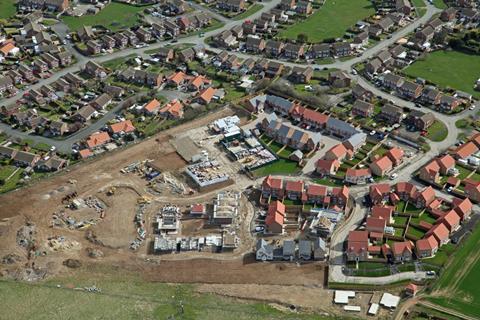Materials body makes sharp downward revisions to forecasts in wake of turmoil caused by mini budget
Private housing starts are set to fall by 10% next year as housebuilding output drops sharply, according to the latest economic forecast from the Construction Products Association.
The materials trade body said it now expected output from the housing development industry to fall by 8.7% overall as completions also slump, in forecasts revised down sharply in the wake of the turmoil caused by the mini-budget and its aftermath.

In addition the organisation said the “risks are heavily weighted to the downside” and said that “considerably greater falls may occur if interest rates rise more than expected and if the housing market hits a tipping point”, predicting a drop private housing output of anything up to 17% in its “lower” scenario.
These sharp falls compare to flat growth that the CPA was predicting for the sector when it made its “summer forecast in July.
The forecast comes days after the Bank of England raised the base rate to 3% and forecast the UK economy has already entered a recession which it expects to last for two years – the longest on record. They also come as Halifax today reported the sharpest month-on-month drop in house prices, in October, for more than 18 months.
In its central forecast, the CPA said that new build output for private will drop by 9% from an expected £38.2bn this year to £34.7bn in 2023, before showing limited growth of 1% in 2024. Meanwhile public housebuilding, which is expected to have already fallen back by 2% this year to £4.9bn, will drop another 6% to £4.6bn.
In total, the CPA forecasts that housebuilding output will drop 8.7% to £39.3bn. Domestic repair and maintenance work is expected to be hit to a similar degree.
>> See also: Savills predicts UK house prices will drop 10% next year
>> See also: Can HAs keep development going as the rest of the market slows?
Despite the recent increase to the base rate, the CPA’s commentary said it now expected the Bank of England base rate to peak at around 4%, rather than the 6% being predicted in the immediate aftermath of the mini budget. However, the CPA said real wage decline and rising interest rates will adversely affect construction, particularly demand for private housing new build and private housing repair, maintenance and improvement.
The predicted drop in housebuilding output came as the CPA sharply downgraded its overall forecast for construction output next year in light of the economic chaos that followed September’s mini-budget.
In the summer the body predicted a 0.4% decline in output in 2023 but has now been revised to a fall of 3.9%, accounting for the impacts of wider economic recession and political uncertainty.

The viability of commercial construction and infrastructure projects are also likely to be impacted by economic headwinds, particularly the continuing concern over construction cost inflation.
Noble Francis, CPA economics director, said it was “worth keeping in mind that activity in the industry currently remains at a historically high level” but that construction would not be immune from the effects of falling spending alongside heavy inflation.
“The largest effects will unsurprisingly be on private housing and private housing repair and maintenance, given that they are reliant on households’ willingness and ability to spend,” he said.
Most major housebuilders have sold through to 2023 Q1 but the CPA said demand will be dampened by rising interest rates, which are expected to peak at 4%. Some existing homeowners may be forced to sell, adding further pressure to the market.
Francis said major clients’ willingness to invest in new commercial developments will also be “tested” with a fall of 5.1% predicted for 2023 following a stagnant 2022.
Infrastructure, while the least affected by household finances and interest rates, will be “adversely affected by central government and local authority spending constraints” and increased pressure for austerity, he added.
Projects towards the end of the government’s Spending Review could get pushed back into the next review and councils may divert finance from infrastructure to cover the rising costs of basic repairs and maintenance.
Overall, after 5.2% growth in 2022, infrastructure output is forecast to rise by 1.6% in 2023 and 2.6% in 2024, driven largely by major projects such as HS2, Hinkley Point C and Thames Tideway.










No comments yet